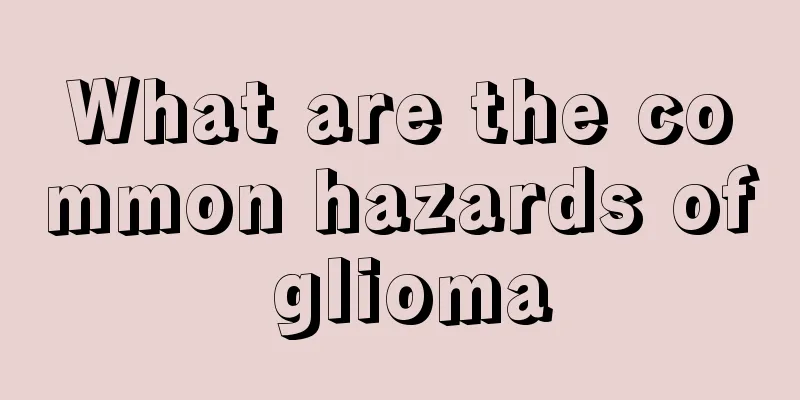What are the common hazards of glioma

|
Glioma is a malignant tumor of the brain. I believe many people know this disease. Once you suffer from this disease, you will suffer from various tortures. Moreover, glioma always recurs repeatedly. Patients have been tortured by the disease and are in great pain. So, what are the common hazards of glioma? 1. Headache: In the early stage, it is often intermittent, throbbing dull pain or distending pain. Later, as the tumor grows, the headache intensifies and lasts longer, and can become continuous. The headache can be localized or general, often occurring in the early morning or on an empty stomach after getting up, and gradually relieved during the day. In severe cases, it may be accompanied by nausea and vomiting, and the headache can be relieved after vomiting; 2. Vomiting is also often the first symptom of glioma, which often occurs in the early morning on an empty stomach. There may or may not be nausea before vomiting, and it is often accompanied by severe headache and dizziness. Sometimes it is jet-like, mostly caused by increased intracranial pressure stimulating the vomiting center. Children with posterior cranial fossa tumors will have early and frequent vomiting, which is often the only early symptom and can be easily misdiagnosed as a gastrointestinal disease; 3. Papilledema is an important objective sign of increased intracranial pressure. Supratentorial tumors are generally heavier on the tumor side, while infratentorial tumors are roughly connected on both sides. Tumors at the base of the frontal lobe directly compress the ipsilateral optic nerve, causing primary atrophy. Countermeasures for papilledema caused by increased intracranial pressure Papilledema may not affect vision for a long time. As papilledema worsens, the physiological blind spot expands, the visual field shrinks concentrically, and the optic disc atrophies secondary to it. Once paroxysmal amaurosis occurs, vision will decline rapidly. Be alert to the risk of blindness and deal with it early; 4. Epilepsy attacks are mostly caused by direct stimulation or compression of the tumor, with an incidence of about 30%. Generally, slow-growing low-grade gliomas such as astrocytomas and oligodendrogliomas have epilepsy as the first or main symptom, while fast-growing malignant glioblastomas have a low incidence of epilepsy; 5. Neurological localization symptoms caused by tumor stimulation, compression or destruction of surrounding brain tissue or cranial nerves, such as frontal lobe glioma can cause damage to the motor area, writing and motor language center, etc., parietal lobe glioma can cause cortical sensory disorders, apraxia, alexia and calculation disorders, etc. Temporal lobe glioma can cause tinnitus and auditory hallucinations, sensory or nomenclature aphasia, vertigo, etc. The above is an introduction to the harmful manifestations of brain glioma. It can be seen how serious it is. Therefore, early detection and early treatment are the key to treating brain glioma. |
<<: What are the dangers of glioma
>>: What are the benign symptoms of tongue cancer
Recommend
How can nails grow faster
Nails are an indispensable part of the human body...
What is the cause of nosebleed
Nosebleeds are a common problem, but we cannot ig...
How to build abdominal muscles
When many people choose to exercise, the first th...
What foods can't be eaten for liver stones
There are some dietary taboos that patients with ...
Does Tianguo have any side effects on the kidneys?
The kidney is a very important organ in the human...
Driving without sunscreen can cause skin cancer. How to protect yourself from the sun and prevent skin cancer in summer
Does having a film on your car windows mean you d...
What should I do to prevent cervical cancer? What are the basic measures to prevent cervical cancer?
Cervical erosion is cervicitis, and most married ...
What are the symptoms of advanced lung cancer?
What are the symptoms of advanced lung cancer? 1....
Hazards of bread additives
Bread is a very common food in modern life. Many ...
What are the earliest symptoms of laryngeal cancer
Laryngeal cancer is divided into supraglottic, su...
What are the side effects of photon hair removal
Body hair is a normal part of our bodies. But som...
Is 38 degrees considered a fever?
If we measure our body temperature, is 38 degrees...
Is it good to take pearl powder internally?
Pearl powder is a very common beauty product that...
Will drinking coffee make your teeth yellow?
Coffee is a very common thing in the daily life o...
Why do I still have urine after I pee even if I push hard
Nowadays, more and more people still have urine c...









